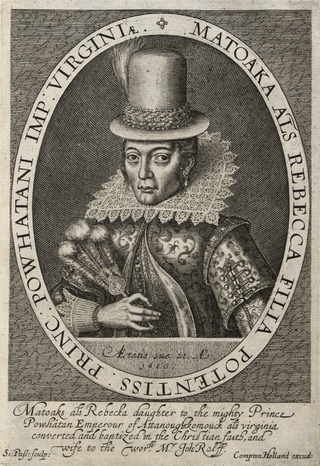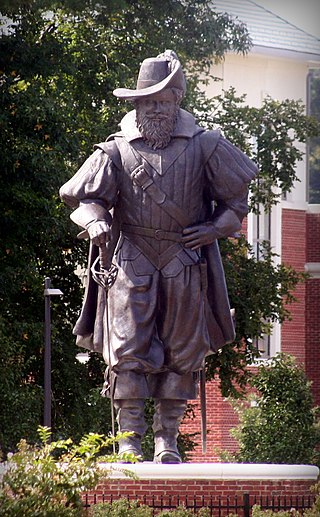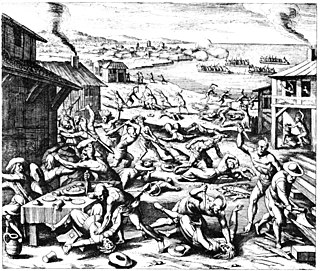Related Research Articles

The Jamestown settlement in the Colony of Virginia was the first permanent English settlement in the Americas. It was located on the northeast bank of the James River, about 2.5 mi (4 km) southwest of the center of modern Williamsburg. It was established by the Virginia Company of London as "James Fort" on May 4, 1607 O.S., and was considered permanent after a brief abandonment in 1610. It followed several failed attempts, including the Lost Colony of Roanoke, established in 1585 on Roanoke Island, later part of North Carolina. Jamestown served as the colonial capital from 1616 until 1699. Despite the dispatch of more settlers and supplies, more than 80 percent of the colonists died in 1609–1610, mostly from starvation and disease. In mid-1610, the survivors abandoned Jamestown, though they returned after meeting a resupply convoy in the James River.

John Smith was an English soldier, explorer, colonial governor, admiral of New England, and author. He played an important role in the establishment of the colony at Jamestown, Virginia, the first permanent English settlement in North America, in the early 17th century. He was a leader of the Virginia Colony between September 1608 and August 1609, and he led an exploration along the rivers of Virginia and the Chesapeake Bay, during which he became the first English explorer to map the Chesapeake Bay area. Later, he explored and mapped the coast of New England. He was knighted for his services to Sigismund Báthory, Prince of Transylvania, and his friend Mózes Székely.

Pocahontas was a Native American woman belonging to the Powhatan people, notable for her association with the colonial settlement at Jamestown, Virginia. She was the daughter of Powhatan, the paramount chief of a network of tributary tribes in the Tsenacommacah, encompassing the Tidewater region of what is today the U.S. state of Virginia.

John Rolfe was an English explorer, farmer and merchant. He is best known for being the husband of Pocahontas and the first settler in the colony of Virginia to successfully cultivate a tobacco crop for export.

Christopher Newport (1561–1617) was an English seaman and privateer. He is best known as the captain of the Susan Constant, the largest of three ships which carried settlers for the Virginia Company in 1607 on the way to found the settlement at Jamestown in the Virginia Colony, which became the first permanent English settlement in North America. He was also in overall command of the other two ships on that initial voyage, in order of their size, the Godspeed and the Discovery.
Samuel Jordan was an early settler and Ancient Planter of colonial Jamestown. He arrived in Virginia around 1610, and served as a Burgess in the first representative legislative session in North America. Jordan patented a plantation which he called "Beggar's Bush", which later became known as Jordan's Journey. It became a safe haven and stronghold for settlers during the Second Anglo-Powhatan War that ensued after the Powhatan surprise attack of 1622.
The Jamestown supply missions were a series of fleets from 1607 to around 1611 that were dispatched from England by the London Company with the specific goal of initially establishing the company's presence and later specifically maintaining the English settlement of "James Fort" on present-day Jamestown Island. The supply missions also resulted in the colonization of Bermuda as a supply and way-point between the colony and England.
John Ratcliffe was an early Jamestown colonist, mariner and captain of Discovery, the smallest of three ships that sailed from the Kingdom of England on 19 December 1606, to English-claimed Virginia to found a colony, arriving 26 April 1607. He later became the second president of the colony of Jamestown. He was killed by the Pamunkey Native Americans in late 1609.

The Indian massacre of 1622 took place in the English colony of Virginia on 1 April [O.S. 22 March] 1622. English explorer John Smith, though he was not an eyewitness, wrote in his History of Virginia that warriors of the Powhatan "came unarmed into our houses with deer, turkeys, fish, fruits, and other provisions to sell us"; they then grabbed any tools or weapons available and killed all English settlers they found, including men, women, and children of all ages. Opechancanough, chief of the Powhatan Confederacy, led a coordinated series of surprise attacks that ended up killing a total of 347 people — a quarter of the population of the Colony of Virginia.
Captain Raleigh Croshaw or Rawley Crashaw was an English merchant and early immigrant to the Colony and Dominion of Virginia who represented Elizabeth City County in the House of Burgesses in 1624.
The Starving Time at Jamestown in the Colony of Virginia was a period of starvation during the winter of 1609–1610. There were about 500 Jamestown residents at the beginning of the winter; by spring only 61 people remained alive.

Anne Burras was an early English settler in Virginia and an ancient planter. She was the first English woman to marry in the New World, and her daughter Virginia Laydon was the first child of English colonists to be born in the Jamestown, Virginia, colony. Anne Burras arrived in Jamestown on September 30, 1608, on the Mary and Margaret, the ship bringing the Second Supply. She came as a 14-year-old maid (lady-in-waiting) to Mrs. Thomas Forrest. In November or December 1608, Anne married John Laydon/Layton/Leyden. The Laydons had four daughters, Virginia, Alice, Katherine, and Margaret. All six members of the Laydon family were listed in the muster of February 1624/5. According to the muster, Anne was 30 years of age when the muster was taken. All four children are listed as born in Virginia; their ages are not given.
Henry Spelman (1595–1623) was an English adventurer, soldier, and author, the son of Erasmus Spelman and nephew to Sir Henry Spelman of Congham (1562–1641). The younger Henry Spelman was born in 1595 and left his home in Norfolk, England at age 14 to sail to Virginia Colony aboard the ship Unity, as a part of the Third Supply to the Jamestown Colony in 1609. He is remembered for being an early interpreter for the people of Jamestown as well as writing the Relation of Virginia, documenting the first permanent English colonial settlement in North America at Jamestown, Virginia, and particularly the lifestyles of the Native Americans of the Powhatan Confederacy led by Chief Powhatan.

Jamestown, also Jamestowne, was the first settlement of the Virginia Colony, founded in 1607, and served as the capital of Virginia until 1699, when the seat of government was moved to Williamsburg. This article covers the history of the fort and town at Jamestown proper, as well as colony-wide trends resulting from and affecting the town during the time period in which it was the colonial capital of Virginia.
Richard Pace was an early settler and ancient planter in colonial Jamestown, Virginia. According to a 1622 account published by the London Company, Pace played a key role in warning the Jamestown colony of an impending Powhatan raid on the colony.

Mistress Forrest and her maid servant Anne Burras, were the first two European women to come to the Virginia Colony. Arriving on October 1, 1608, in what is known as the Second Supply aboard the English ship the Mary and Margaret under Captain Christopher Newport to resupply the colony at Jamestown, Virginia. Her husband Thomas Forrest (colonist) Esq. was listed as a gentleman on that ship as shown on its manifest, whereas she was listed only as Mistress Forrest. Thomas and Margaret had married on August 16, 1605, in St. Giles in the Fields, London, England.
Cecily Jordan Farrar was one of the earlier women settlers of colonial Jamestown, Virginia. She arrived in the colony as a child in 1610 and was established as one of the few female ancient planters by 1620. After her husband Samuel Jordan died in 1623, Cecily obtained oversight of his 450-acre plantation, Jordan's Journey. In the Jamestown Muster of 1624-1625, she is one of fewer than ten women mentioned as a head of household and the only woman listed as sharing the head of household with a man she was not married to. In the year of Samuel Jordan's death, she set off the first breach of promise lawsuit in English North America when she chose the marriage proposal of William Farrar, who was bonded to help settle her estate, over that of Greville Pooley, who claimed his proposal had already been accepted. In 1625, Cecily prevailed when Pooley withdrew his claim. Afterward, she married William Farrar.
Michael Sicklemore was an English gentleman, soldier and explorer. He was a colonist with the Jamestown first supply and led an unsuccessful expedition to find traces of Walter Raleigh's lost Roanoke Colony.
Jonas Profit was an English mariner and explorer. He was a colonist with the Jamestown first supply and an early fisherman and fishmonger in the Colony of Virginia.
This is a timeline of events related to the settlement of Jamestown, in what today is the U.S. state of Virginia. Dates use the Old Style calendar.
References
- ↑ Dorman, pp. 105-107
- ↑ Nicklin, John Bailey Calvert (1929). "Descendants of Captain Robert Behethland of Jamestown". The William and Mary Quarterly. 9 (1): 60. doi:10.2307/1920378. JSTOR 1920378.
- ↑ A map of Virginia with a description of the countrey, the commodities, people, government and religion
- ↑ Smith, page 106.
- ↑ Smith, page 164.
- ↑ Smith, pages 164-166.
- ↑ "Ancestors". Order of Descendants of Ancient Planters. 13 October 1991. Retrieved 10 February 2024.
- ↑ "Robert Beheathland". jamestowne-wash-nova.org. Archived from the original on 11 July 2016.}
- ↑ Dorman, pp. 105-107
- ↑ Dorman, pp. 105-107
- ↑ Gray, p. 1-7: p. 6 quotes Cavaliers & Pioneers, Minutes of Council & General Court
- ↑ Dorman, pp. 105-107